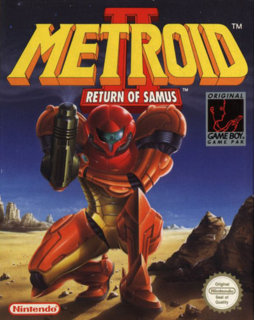Apparently, what happens on SR-388 happens after the events of the Metroid Prime cycle. So yes, you need this game.
Having said that, this is still a Metroid game through and through, and a high-quality one at that.
The story has Samus sent off to planet SR-388, to eliminate the Metroid threat. This plot device manifests itself in a Metroid counter, cluing Samus into how many Metroids she has yet to defeat and how many remain before a new pathway opens up. With a couple notable exceptions, the combat with Metroids are the game's only de facto boss fights. Metroid II is a fairly linear game, but veteran Metroid players have found and will continue to find many sequence breaking opportunities. The best aspect of the gameplay is just how big the world of SR-388 actually is, and also just how many ways there are to explore it. Metroid II contains an under-appreciated item which is absent from Super Metroid and Metroid Fusion, but is implemented well in Metroids Prime 1 and 2 (especially 2) but even moreso in Metroid II itself believe it or not! It isn't used in combat or as part of elaborate and memorable puzzles in this game, but it is an indispensible, yet unbroken item. The Metroids you encounter take on forms never before or since seen in a Metroid game, they are strange and offer disparate challenges, and are the best looking sprites in the game.
Samus' suit is rendered with good artistic detail, but poor technical detail of course. One can immediately tell the Power Suit model from the Varia suit model without much effort. The environments are differentiated well despite the GameBoy's hardware limitation, and the architecture and landscapes look better than most other games for the antique handheld.
Metroid II's sound is its strongest point. The game's music is subtle, almost to the point of white noise in some cases; but it gives SR-388 an atmosphere that is markedly different from the Alymbic Cluster, the B.S.L. Space Station, Tallon IV, and Zebes. One feels just as alone on SR-388 as one does on Zebes, but that loneliness is tinted with a hint of the surreal.
Metroid II's story is thin, it serves little purpose other than to tie the events of the original and Super Metroid together, but contains some visual plot devices that will have enthusiasts re-thinking their interpretations of the Metroids Prime.
By "today's standards", Metroid II is an inacessible game -- it offers no tutorial, little plot, and a painfully sparse colour pallete -- but none of this means that enthusiasts should skip over it. It offers the most significant challenge of all the Metroid games, and it does the Metroid formula as well as the best of them. In short, Metroid II: Return of Samus comes highly reccomended to any fledgling Metroid fan.

